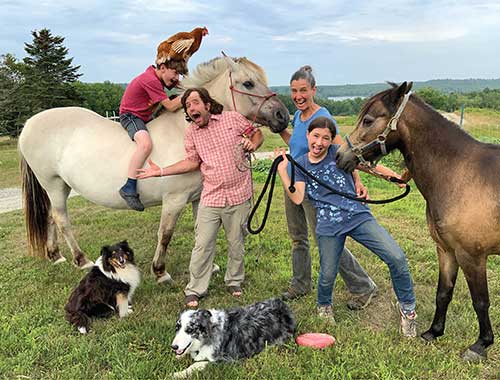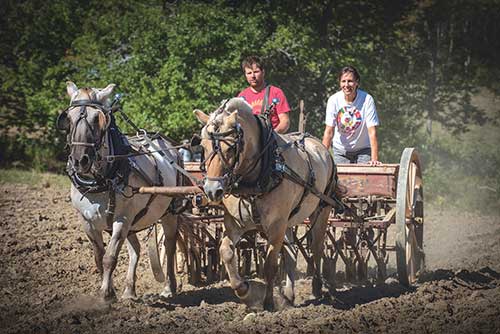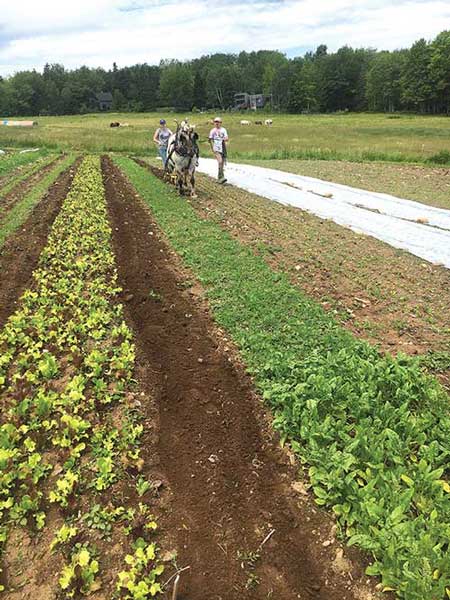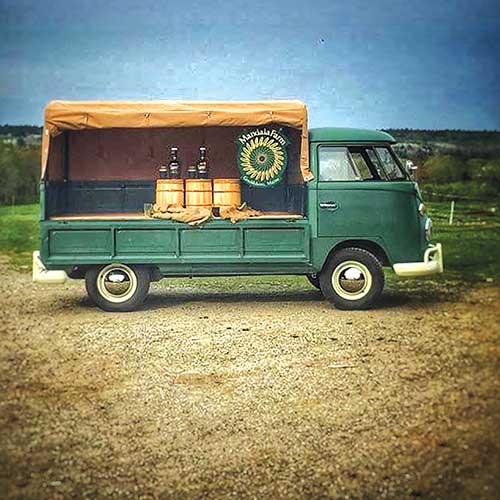 |
| Some of the Mandala Farm family: front: Licorice and Shadow; back: Ross riding Kristi with Peg the chicken, Genio, Sara, and Enna with Rosie. Photo courtesy of Mandala Farm |
 |
| Genio driving Fjorgyn and Grane on a Cockshutt grain drill, seeding a cover crop of oats. Photo by David McCudden |
 |
| Two apprentices learning to drive a walking cultivator between beds. Photo courtesy of Mandala Farm |
 |
| The farm’s 1965 VW single cab transporter – the family truck for 54 years! Photo courtesy of Mandala Farm |
By Sonja Heyck-Merlin
Photos courtesy of Mandala Farm
Sara Faull and Genio Burtin were in their mid-20s when they purchased Mandala Farm in 2002. The 100 acres is on the Schoodic Peninsula in Gouldsboro, the easternmost town in Hancock County. The farmstead sits atop a hill with their 40 acres of fields sloping eastward to meet the shores of Jones Pond. Faull and Burtin have two children – Enna (12) and Ross (10). Burtin’s parents also live and work on the farm.
When the Natural Resources Conservation Service soil specialist first walked the fields with Faull and Burtin, he joked that they could always sell gravel if they needed to. Selling gravel wasn’t what the couple had in mind, though. Having already rescued the property from development, they wanted to put their horses to work.
For the Love of Horses
Since she started riding at age 10, Faull has wanted to be near horses. After graduating from College of the Atlantic, she and Burtin fell in love with the Fjords at the H.O.M.E. Cooperative, a homeless shelter, food pantry and arts collective in Orland, Maine.
The Fjord is a versatile pony breed recognizable by its dun color and the dark stripe that runs down the center of its light-colored mane. On average, Fjords stand 13.2 to 14.2 hands high and weigh 900 to 1,200 pounds.
What began as a two-week experience with the Fjords at the co-op became the couple’s focus for the next three years. There they learned how to drive the horses mostly by hauling firewood. While with the organization, each year they brought the shelter’s Fjords to the Common Ground Country Fair, where they met many of Maine’s renowned teamsters and started dreaming about their own farm. When they left H.O.M.E, the organization gifted them the majority of its livestock: five Fjords including a stallion and flocks of sheep and cashmere goats.
“We came to farming differently than most,” Burtin says. “We decided to farm so that we could use the horses and see what we could accomplish with them.” A desire to promote social change through farming was as important as the horse impulse.
The Routine Pleasure
Burtin is quick to say that his role on the farm is that of the farmer’s husband. In addition to farming, he works as a housewright. Faull orchestrates the day-to-day activities, which revolve around 2 1/2 acres of MOFGA-certified organic vegetable production and diverse livestock enterprises.
Because their open land drops 150 feet of elevation in a quarter of a mile, flat land is scarce, so the growing plots are small and far apart. The largest is a quarter of an acre.
The couple first developed its horse farming system to be apprentice-friendly, but due to COVID-19, 2020 was the first time in 18 years that they haven’t shared their home with apprentices. When they did have apprentices, they used a team of two people for each horse-powered task in order to provide plenty of driving time and a safe experience. One person would practice driving the horse using long lines, while the other handled the walk-behind implement.
Teamster and vegetable farmer Sophia Bates of Mendocino County, California, recalls her two years at Mandala. “If you were interested in the horses, you were driving them in your second week. I don’t think there is anywhere else in the country where you can get the type of horse farming experience provided at Mandala.”
Burtin and Faull could provide this hands-on experience to apprentices because they had four reliable horses. The untimely deaths of three of them from various causes and a dwindling apprentice pool prompted Faull to adopt riding implements that she could use alone.
Faull now begins the growing season by hitching the team to an Oliver No. 23 two-way sulky plow. The plow has two bottoms but uses only one at a time. At the end of a row, Faull stops the team, turns the horses, lifts one bottom and drops the other as she reverses direction. She follows plowing with a disc harrow and a spring-tooth harrow to prepare the soil for planting.
“The majority of our equipment,” Burtin says, “is from the late ‘40s and early ‘50s and comes from the stonewalls between Gouldsboro and Unity.” A teamster friend refers to their farm as “living the past with Sara and Genio,” largely because they intentionally use antique equipment rather than modern technologies adapted for horse farming.
They grow a full range of market vegetables, selling 75% to restaurants and retail stores on Mount Desert Island and the rest through their CSA, self-serve farm stand and the Winter Harbor Farmers’ Market.
“We have a relationship with five chefs in Bar Harbor and some retailers that are committed to us as a farm and are willing to work with us on whatever’s available,” Burtin says. He cuts a distinctive figure on MDI during his bi-weekly deliveries in a 1965 Volkswagen single cab transporter. The market rig is part bus, part van. Burtin restored it from rough to shiny. Regarding COVID-19 and their Bar Harbor markets, Faull and Burtin were cautiously optimistic when interviewed in early summer. In reality, they won’t know the impact of the virus until the end of the tourist season.
Throughout the year Faull and Burtin also use the horses to haul in crops such as garlic and winter squash, to spread manure, plant cover crops, move firewood and haul sap for their homestead-scale maple syrup production.
“In our early years,” Faull says, “we cultivated less ground and planted more intensively. After planting, the horses were only used to cultivate the pathways.” Now they plant most crops in single rows 36 inches on center so that they can use a riding cultivator and spend less time weeding by hand. They still grow salad mix, a significant crop on the farm, in a bed system and weed it manually.
Faull loves the synchronicity among the land, the horses and herself. “There is a routine pleasure that comes from the horses, whether I am harnessing, leading them to pasture or doing field work,” she says. “It’s different than getting on a tractor. I take no pleasure in greasing a tractor.”
The farm now has 13 horses: five in the work category, two boarders, some retirees, and a posse of three ponies to ensure that the kids will find pleasure in the horses.
The five work horses were born at the farm. While the couple had no intention of breeding horses when they started Mandala, the stallion they were gifted seemed like too good of an opportunity to pass up, so 25 foals have been born on the farm. When their stallion died, they chose not replace him.
For all of the foals born on the farm, Faull used a process called imprint training, which involves exposing newborn foals to stimuli they will encounter throughout their life. For example, each part of the body is rubbed and manipulated until the foal relaxes.
Robert Miller, DVM, author of “Imprint Training of the New Born Foal,” says imprint training achieves four goals: It bonds the foal to humans, teaches the foal submission but not fear, desensitizes the foal to most sensory stimuli and sensitizes the foal to performance-related stimuli.
Post-imprinting, Faull mostly left the foals alone except to lead them in and out of pasture and to pick their feet. “This daily process,” she says, “got them used to being led and having to listen.” As they grew older, she trained the horses in harness to ground driving. Eventually they were teamed up with a mentor horse and hitched to an implement in the field.
The Full Spectrum of Life
In addition to the horses, the farmers have 200 laying hens, a dozen sheep, a dozen cashmere goats, three farm dogs, two house cats and a family milk cow. They also raise and process 1,200 broilers each year. Until 2020 they also raised pigs.
When they moved to the farm, it had about 20 open acres. A decade ago the couple cleared an additional 20 acres, which they refer to as the clear-cut. It is fenced with woven wire and grazed by the sheep and goats.
The horses rotationally graze through large fixed paddocks on the 10 acres of older interior pastures. Each evening they are led back to the barnyard atop the hill where they spend the night in an outdoor paddock.
The 1,200 broilers, raised in groups of 40 to 60 in chicken tractors, occupy the remaining 10 acres of pasture. The Quonset-style 8-by-10-foot chicken tractors stand 4 1/2 feet tall, so the farmers can easily get into them and catch the chickens. The broilers are processed weekly on-farm in a facility that is licensed for up to 20,000 birds per year.
At the end of the pasture season, the sheep, goats, horses and milk cow transition to winter housing: two barns and several small run-in sheds. Winter manure and bedding accumulate in a 30-by-35-foot covered storage facility that has an attached 40-by-80-foot concrete pad. In the spring the farmers push the stockpiled manure onto the concrete pad and form compost windrows. Mandala imports no fertility other than 10 gallons of fish emulsion per year.
Vera, Burtin’s mother and proud grandmother of Ross and Enna, helps with day-to-day farm chores, including the livestock. She treasures the unique interactions the animals provide, particularly to the children. “You see the wonders that they have at their fingertips in witnessing the full spectrum of life and death. For them, they have a real picture of what it’s all about.”
Shared Experience
Not just Ross and Enna thrive from the diverse experiences offered by Mandala. “From day one we realized the importance of sharing both knowledge and experience,” Burtin says, with much of their learning and sharing taking place at the Common Ground Country Fair. This will be the first time in 18 years that they have missed the event. In previous years they loaded up the kids, the harnesses and some horses and camped out for the whole weekend. It’s such a tradition that one year they even brought Ross with a freshly broken femur.
Their early years at Common Ground were crucial to their development as farmers. “You have to remember,” Burtin says, “that we started farming pre-YouTube. I remember trying to follow the three pages of a poorly photocopied extension bulletin on how to process poultry. Now you can absorb an incredible amount of information in a two-minute video.”
While one can learn how to harness a horse or acquire horse training techniques from video, the palpable experiences and connections the Fair provides are irreplaceable. Some of the couple’s most memorable horse experiences at the Fair include cutting, binding and threshing a field of oats, hitching up an eight-mule team, and watching their foals experience the Fair for the first time.
In addition to hosting apprentices and presenting at the Fair, in 2011 the couple established a nonprofit organization called Farm Tomorrow. Its mission is to preserve, exchange, promote and teach rural and traditional farming practices. The farmers achieve that through on-farm programs for school children; satellite workshops for camps, colleges and 4-H groups; and more intensive classes for teamsters.
Above all, Faull and Burtin believe in sharing their farm with children. “By exposing children to food systems, they will develop an appreciation and understanding of food and its origins. We believe that by teaching children about agriculture through participation, we will be developing a lifelong knowledge and appreciation of farms, the value of farmland, and the importance of farms in their communities,” they say on the Farm Tomorrow website.
“In the beginning,” the pair says, “many of our ideas were at a homestead scale. Our early ideal was to be a full-circle [self-sufficient] farm. Over the years, we’ve made changes related to modern realities: time constraints, coastal weather, lack of 100 years of knowledge, and the economics of having to cover the costs of living.”
While they have made some trade-offs – they purchase their hay and grain, bust out a bush-hog from time to time, and use a gator to move produce post-harvest – their current business model hasn’t sacrificed their horse farming ideals. Nor have they compromised their commitment to provide nutrient-dense food and educational opportunities for their community.
“Everyone who experiences Mandala seems to leave with a sense of wholeness,” Vera says. “There is something so enchanting, a serenity on this farm that just hugs everyone.”
About the author: Sonja Heyck-Merlin is a regular feature writer for The MOF&G. She and her family own and operate an organic dairy farm in Charleston, Maine.
